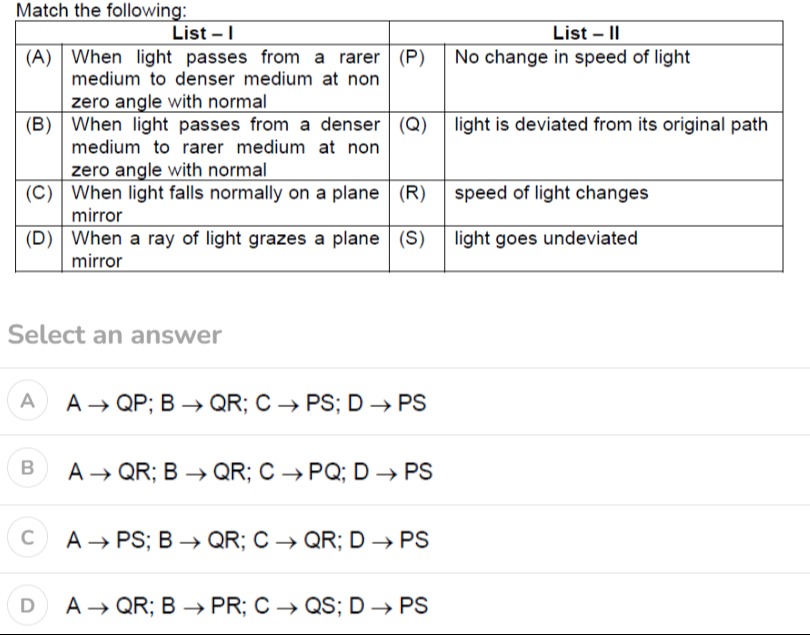Question
Question: Match the following: | | List - I ...
Match the following:
| List - I | List - II | ||
|---|---|---|---|
| (A) | When light passes from a rarer medium to denser medium at non zero angle with normal | (P) | No change in speed of light |
| (B) | When light passes from a denser medium to rarer medium at non zero angle with normal | (Q) | light is deviated from its original path |
| (C) | When light falls normally on a plane mirror | (R) | speed of light changes |
| (D) | When a ray of light grazes a plane mirror | (S) | light goes undeviated |

A
A → QP; B → QR; C → PS; D → PS
B
B → QR; B → QR; C → PQ; D → PS
C
C → PS; B → QR; C → QR; D → PS
D
D → QR; B → PR; C → QS; D → PS
Answer
Ideally: A -> QR, B -> QR, C -> PS, D -> PQ. However, none of the given options are fully correct.
Explanation
Solution
Let's analyze each statement from List-I and determine the corresponding properties from List-II.
List-I Analysis:
(A) When light passes from a rarer medium to denser medium at non-zero angle with normal:
- Speed of light: When light enters a denser medium from a rarer medium, its speed decreases. Therefore, "speed of light changes" (R) is applicable.
- Deviation: Since the angle with the normal is non-zero, the light ray will bend towards the normal (refraction). Therefore, "light is deviated from its original path" (Q) is applicable.
- Conclusion for (A): A → Q, R
(B) When light passes from a denser medium to rarer medium at non-zero angle with normal:
- Speed of light: When light enters a rarer medium from a denser medium, its speed increases. Therefore, "speed of light changes" (R) is applicable.
- Deviation: Since the angle with the normal is non-zero, the light ray will bend away from the normal (refraction). Therefore, "light is deviated from its original path" (Q) is applicable.
- Conclusion for (B): B → Q, R
(C) When light falls normally on a plane mirror:
- Speed of light: Reflection occurs in the same medium, so the speed of light does not change. Therefore, "No change in speed of light" (P) is applicable.
- Deviation: When light falls normally (perpendicularly) on a mirror, it reflects back along the same path. This means it does not deviate from its incident direction. Therefore, "light goes undeviated" (S) is applicable.
- Conclusion for (C): C → P, S
(D) When a ray of light grazes a plane mirror:
- "Grazes" means the angle of incidence is 90 degrees (the ray is parallel to the mirror surface).
- Speed of light: Reflection occurs in the same medium, so the speed of light does not change. Therefore, "No change in speed of light" (P) is applicable.
- Deviation: According to the law of reflection, if the angle of incidence is 90 degrees, the angle of reflection is also 90 degrees. The ray reflects back along the surface in the opposite direction. This is a significant change in direction, so the light is "deviated from its original path" (Q). It does not go undeviated.
- Conclusion for (D): D → P, Q
Summary of correct matches:
- A → Q, R
- B → Q, R
- C → P, S
- D → P, Q
None of the options match the derived correct matches. Therefore, the question is flawed.
